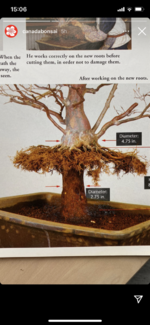Lol. For a zen hobby folks seem to be a little edgy. I, like anyone who picks up bonsai, understand these are long term projects. Personally, I tend to be obsessive and go down the rabbit hole so before I ask a question there was at least a modicum of effort (more likely hours) to find an answer myself and otherwise educate myself.
I have only a few maples. Some are in The ground and will remain there basically untouched for years to come to allow the trunks to develop. Another is on a tile in a grow box. Yet others will get a trunk chop come spring. I have permission to air layer an array of cultivars and my sons (they got me into this craziness) have their own elms, pines and (dare I say) portulacaria. Not much to do now, but I will have my hands full come spring.
The shishigashira was an impulse buy. I don’t have to do anything with him as he looks beautiful as is where is. The ultimate plan however is to have the part where it splits become the base (seems like a ground layer at some point).
If this was a big box maple that I wanted for landscaping, I’d get him out of the pot and give his roots a nice box cut before planting him. Circling/girdling root problems basically solved. But this isn’t intended to be a landscaping tree.
If I didn’t want any air layers, in the early spring I’d heavily prune the roots AND do a heavy branch pruning.
Here, I do want air layers, especially of branches that are rather thick and developed. I’d also like to layer off the root stock. I understand that I can’t layer off the root stock and take air layers at the same time. The ground layer will need to wait.
All that said, I still have a massive tree sitting in a 15 gallon pot that probably hasn’t been reported in years and instead additional soil was added to the top year after year, burying this bad boy.
My knee jerk reaction, which can be totally off (that’s why I turn to the folks on Bonsai Nut), is that roots and soil come first. I now understand that, even though this guy has a giant established root system, I cannot repot him with a root prune AND then start the air layers.
Assuming I want air layers before I chop him down and want to ultimately layer off the root stock, would the best place to start with this tree be to deal with the roots and simply wait on the air layers for another year?
just looking for advice/best practices from those who can help shorten the learning curve.
I have only a few maples. Some are in The ground and will remain there basically untouched for years to come to allow the trunks to develop. Another is on a tile in a grow box. Yet others will get a trunk chop come spring. I have permission to air layer an array of cultivars and my sons (they got me into this craziness) have their own elms, pines and (dare I say) portulacaria. Not much to do now, but I will have my hands full come spring.
The shishigashira was an impulse buy. I don’t have to do anything with him as he looks beautiful as is where is. The ultimate plan however is to have the part where it splits become the base (seems like a ground layer at some point).
If this was a big box maple that I wanted for landscaping, I’d get him out of the pot and give his roots a nice box cut before planting him. Circling/girdling root problems basically solved. But this isn’t intended to be a landscaping tree.
If I didn’t want any air layers, in the early spring I’d heavily prune the roots AND do a heavy branch pruning.
Here, I do want air layers, especially of branches that are rather thick and developed. I’d also like to layer off the root stock. I understand that I can’t layer off the root stock and take air layers at the same time. The ground layer will need to wait.
All that said, I still have a massive tree sitting in a 15 gallon pot that probably hasn’t been reported in years and instead additional soil was added to the top year after year, burying this bad boy.
My knee jerk reaction, which can be totally off (that’s why I turn to the folks on Bonsai Nut), is that roots and soil come first. I now understand that, even though this guy has a giant established root system, I cannot repot him with a root prune AND then start the air layers.
Assuming I want air layers before I chop him down and want to ultimately layer off the root stock, would the best place to start with this tree be to deal with the roots and simply wait on the air layers for another year?
just looking for advice/best practices from those who can help shorten the learning curve.



